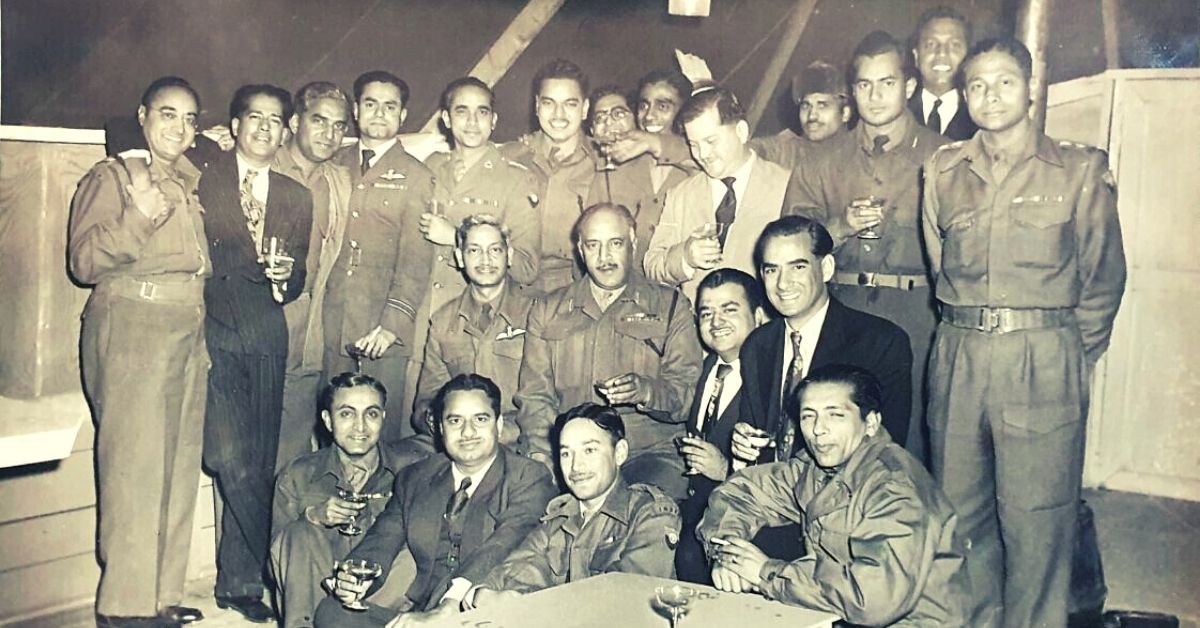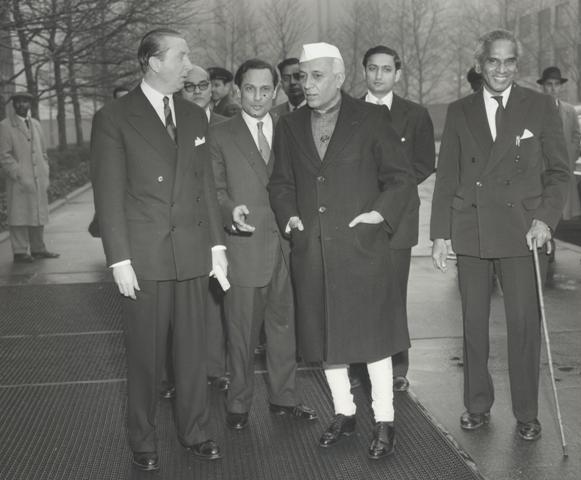When India Brought Peace to Korea & Looked After Its 200,000 Wounded Soldiers
While Indian diplomats worked full time behind the scenes to get the international community on board for their peace proposals, it was the on-ground soldiers who ensured that India followed through on its promises, bringing peace in Korea.

On 27 July 1953, the Korean Armistice Agreement brought about a complete cessation of hostilities following three long years of war on the Korean Peninsula. The armistice agreement was signed between the Western alliance led by the United States—under the umbrella of a United Nations resolution, called the UN Command, which supported present-day Republic of Korea—and the Communist alliance of North Korea and China (known as the Korean People’s Army and Chinese People’s Volunteers, respectively) with support from the erstwhile Soviet Union.
The agreement was signed in the truce village of Panmunjom.
Image above: Members of the Neutral Nations Repatriation Commission with the Chairman General KS Thimayya seen seated in the middle row. (Image courtesy: Facebook/Swapna Liddle)
In his detailed researched paper, called ‘Between the Blocs: India, the United Nations, and Ending the Korean War’, published in The Journal of Korean Studies, Robert Barnes, a British historian, talks about the “much overlooked but significant role” India played in bringing the Korean War to an end. In his paper, the focus is predominantly on Jawaharlal Nehru, but he also talks about the role India’s diplomats played in crafting and executing a campaign of bringing peace. It begins with BN Rau, India’s Permanent Representative to the United Nations. They played an active role in bringing together all stakeholders on board as a UN Cease-fire Committee member in 1950/51.
The committee was to lay the principles of “an immediate cease-fire followed by the staged withdrawal of all armed forces from Korea; the creation of a political machinery whereby the Korean people could express themselves freely on their future; and affirmation that the United States, Britain, the Soviet Union, and China would seek a peaceful settlement of all outstanding East Asian issues after the cessation of hostilities,” writes Barnes.
However, Rau’s efforts didn’t go very far with the United Nations eventually branding the People’s Republic of China as an aggressor and enacting sanctions against them. Other diplomats who played a critical role was KM Pannikar, Indian Ambassador to China, through whom Chinese Premier Zhou Enlai articulated his position to both the United States and the UN since at the time the People’s Republic of China wasn’t a member of the global body.
But in the autumn of 1952, when tensions between the UN Command and the Communist bloc grew further, VK Krishna Menon, the former Indian High Commissioner to Britain, and Nehru’s close confidante, who organised India’s efforts on the world stage. Disliked by both the Soviets and the Americans, Menon represented Nehru’s views on Korea, according to Barnes. Still, the Indian delegation at the UN General Assembly was officially led by Vijaylakshmi Pandit, the Indian Ambassador to the United States.
Building the Neutral Nations Repatriation Commission (NNRC)
One of the biggest contention points between the UN Command and the Communist Bloc was the repatriation of Prisoners of War (POWs) since many prisoners didn’t want to go back to their home countries after the war.
The first attempt at peace talks held at Panmunjom on 25 October 1951 couldn’t solve the issue of prisoner swaps. Many POWs, particularly those held by the UN Command, had refused to return to their home countries.
This was unacceptable to the Chinese and North Koreans. However, despite multiple setbacks to the peace process, our diplomats continued to push for peace.
“Evidently, throughout the UN General Assembly session in the autumn of 1952, India did play an important role. The Indian delegation, especially Menon, had resolutely pursued a compromise solution to the prisoners of war question even if this created friction with the [US President Harry] Truman administration. Yet the delegation had also demonstrated great flexibility, effectively working with its Commonwealth partners, and modifying the proposal in an attempt to make its terms acceptable to both sides,” notes Barnes.
At the UN General Assembly in November 1952, India proposed the establishment of a Neutral Nations Repatriation Commission that would facilitate a smooth exchange of POWs.
“India’s stance was clear: under the provisions of the Geneva Prisoners of War Convention, force could not be used against prisoners of war to prevent or impact their return to their homelands. Under the proposal, the status of the prisoners who had not been repatriated following the expiry of 90 days after the armistice, would be determined by a post-war political conference. Despite initially facing resistance from China and Russia, India’s resolution was accepted in December 1952 at the UN General Assembly,” notes this article in The Indian Express.
Finding a solution to prisoner swaps is what convinced both sides to sign the Korean Armistice Agreement. But Menon and Nehru understood that merely signing the agreement wasn’t going to be enough. There had to be a thorough follow through on its stipulations.
One of the stipulations of the Armistice Agreement was the creation of the Neutral Nations Repatriation Commission (NNRC) headed by India and flanked by Sweden and Switzerland from the Western alliance, while Poland and Czechoslovakia represented the Communist bloc. India was also responsible for providing a brigade of soldiers who would offer security for this delicate exchange of prisoners.
“The NNRC decided the fate of the remaining 20,000 POWs, and their repatriation, also called the Big Switch. It followed Operation Little Switch in April-May of 1952, which saw the exchange of wounded and sick soldiers held by both sides. The solution included handing over these prisoners to the NNRC headed by India. A full Indian contingent of nearly 6000 called Custodian Force of India (CFI) were to take over physical custody of these prisoners; this was our nation’s initiation into peacemaking and conflict resolution,” writes Colonel DPK Pillay, a scholar with the Manohar Parrikar Institute for Defence Studies and Analyses, for the Economic Times.
Chairing the NNRC was General KS Thimayya, a legendary figure in the Indian armed forces, while Ambassador BN Chakravarty of the Indian Foreign Service was appointed as Alternate Chairman. Lt. General SP Thorat, meanwhile, headed the CFI. However, many member states of the UN didn’t think India could pull off this endeavour.
“India, with its brigade-sized contingent, provided security to the POW camps…The Indians took their role of neutrality seriously and didn’t intend to use force like Americans had done earlier to break dissent and non– cooperation in the camps. Their professional ability and gentlemanly qualities earned them respect and regard of both the Commands and the soldiers and statesmen of nearly a dozen nations… General Thorat and the CFI earned respect for their soldierly conduct and humane approach while projecting the neutral and humanitarian policy of the Indian Government,” writes Colonel (Retd.) Pillay, in an another article.
In the face of growing pressure from the Chinese who demanded the forceful repatriation of their soldiers, the CFI worked closely with the UN in explaining to each prisoner their rights and how they could either choose to go home or remain with the side that captured them. “This called for compassion, fairness, and neutrality on the part of the Indian Custodian Force, who rendered yeoman service during the entire span of their mission from September 1953 to March 1954. On several occasions, intricate situations were resolved only because of the patience and tact of General KS Thimayya and Major General SPP Thorat,” he writes for the Economic Times.
By the end of the exercise in March 1954, about 80-100 POWs left who didn’t wish to be repatriated to either country and expressed a desire to live in a neutral country.
In a column by Jairam Ramesh for The Hindu, he notes how out of “humanitarian considerations” Nehru decided to bring them to India awaiting a final decision by the UN about where they would end up going. While many left for Central and South America, a few stayed back in India. Even to this day, General Thimayya, a war hero in India, is remembered in Korea for the role he played in bringing an end to hostilities.
For his yeoman service in Korea, he was awarded the Padma Bhushan in 1954. Meanwhile, Major General Thorat received the Kirti Chakra for his handling of a POW strike that had initially resulted in the abduction of an Indian soldier before he found a peaceful resolution, and Padma Shri for his distinguished service in Korea.
Moreover, even before all these events took shape, India had sent its best medical unit, the 60th Para Field Ambulance (also known as 60th Para), commanded by Lieutenant Colonel AG Rangaraj to treat injured soldiers on the battlefield. The 60th Para provided assistance to 200,000 wounded soldiers and carried out about 2,300 field surgeries, notes this article in The Diplomat. They were eventually merged into the CFI.
While diplomats worked full time behind the scenes to get the international community on board for their peace proposals, it was the soldiers on the ground who ensured that India followed through on her promises. That combination brought peace to Korea.
(Edited by Yoshita Rao)
Like this story? Or have something to share? Write to us: [email protected], or connect with us on Facebook and Twitter.
This story made me
- 97
- 121
- 89
- 167
Tell Us More
We bring stories straight from the heart of India, to inspire millions and create a wave of impact. Our positive movement is growing bigger everyday, and we would love for you to join it.
Please contribute whatever you can, every little penny helps our team in bringing you more stories that support dreams and spread hope.



















